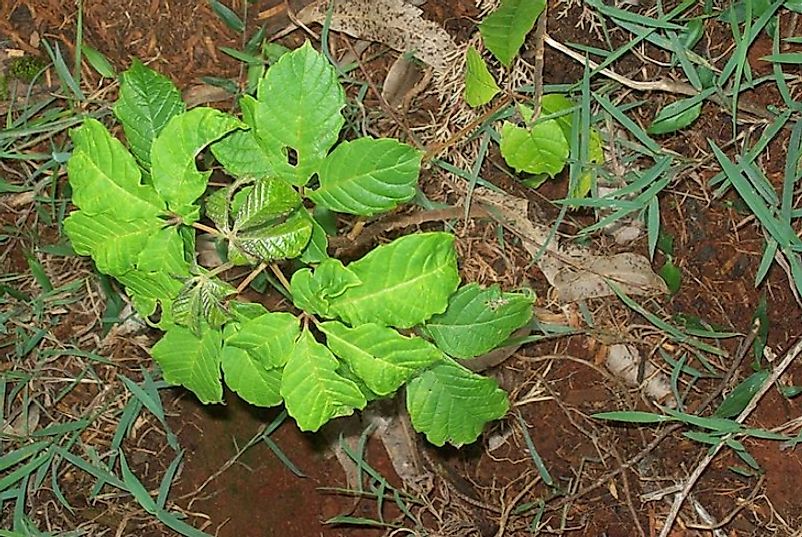Native Plants Of Kenya

Kenya's native plants include the Meru Oak and the Parasol Tree, both of which are threatened endemic species. The country has diversified plant life that occurs in different parts of the country from the coastal regions to the savannah grassland areas and the highland forests. Some of these plants are endemic to the country. Its variation in altitude and climate restricts the plants to some habitats where the conditions favor their growth and survival. Among the fauna of Kenya are the coastal rain forests, the montane forests, desert vegetations, aquatic plants, and the crop or cultivated plants.
Native Plants Of Kenya
Meru Oak (Vitex Keniensis)
The tree is endemic to Kenya and has a large and straight trunk with branches. Its leaves are light green, and these leaves occur as five leaflets arranged in a star formation. Each leaflet has a prominent midrib, a long petiole and can be up to 25 centimeters long. Flowers are small and have five lobes, four of which are white and one lobe is lilac. Its fruits are small, blue-black in color and occur in loose and flat panicles. It grows in moist evergreen forests. It occurs in some parts of the central highlands and the northeastern slope of Mt. Kenya. Meru oak is on the International Union for the Conservation of Nature (IUCN) Red List as a highly endangered species. The tree has been over-exploited because of its ability to produce excellent charcoal. The plant conservation program in Kenya manages a living collection of the trees as well as a stock of its seeds.
Parasol Tree (Polyscias Kikuyuensis)
The parasol tree is endemic to Kenya, and is said to appear similar to an inverted umbrella. It has a straight and branchless trunk that can be up to 12 meters tall. Leaflets occur in three to six pairs and are often straight. Fruits are black and round. The tree is confined to the wet rainforest and scattered in parts of central Kenya. The tree produces excellent timber and thus harvested for fuel purposes. Over-exploitation has made it rare. It is considered Vulnerable by IUCN. The Kenya Forestry authorities keep some of its plantations and its seeds. Small populations are in Mt. Kenya National Park and other forest reserves.
Mpaga (Adenia Globosa)
The plant is native to tropical Africa and is found in Kenya, as well as Tanzania, Ethiopia, and Somalia.The mpaga plant belongs to the passionflower family. Mpaga is a climbing shrub which has a trunk of up to 8 meters tall. The stem is usually succulent and has thorns that can be up to 8 centimeters long. Leaves have an alternate arrangement and are triangular in shape. The flowers are green and solitary. Separate plants have the male and female flowers. It produces round leathery and green fruits. It grows in savannas, forests, and shrublands. It serves as an ancient medicine for abdominal pains and itching. The Maasai community of East Africa uses the plant as a medicine for their cattle. The shrub occurs in broad ranges, and large population hence is not under any threat of extinction. The plant is classified as least concern facing no threat because they are in large numbers and are found in protected areas.
Spanish Tamarind (Vangueria madagascariensis)
The plant is native to Kenya, Tanzania, South Africa, and Angola, among several other Sub-Saharan African countries. The Spanish tamarind is a shrub that grows up to 2 to 15 meters tall. It has a smooth gray bark with a white slash. Leaves occur in rotundates, and are dark green above and paler beneath, with a stalk of 5 to 10 millimeters long. It has greenish-yellow flowers with dense axillary cymes and produces a sweet scent. Fruits are edible, round, smooth and shiny. The shrub grows in tropical areas and is widely distributed in the African continent. People also cultivate it for its fruits. The shrub is drought tolerant and well adapted to a variety of soil, thus listed as least concern by the IUCN.
Conservation of Kenyan Flora
Kenya's unique flora is widely distributed all across the country. Some of the native plants of Kenya include the Sage bush, and the Sand Forest Poison Rope found in the coastal forests and rocky woodland, Mtondoo tree found in coastal regions, green-twigs Quar, the Cherengani Hills Giant Groundsel and the Black Ironwood tree. The Kenya Forest Authorities and Conservation Programs work hard to ensure the survival of these native plants by protecting their habitats and keeping a stock of their seeds.
Native Plants Of Kenya
| Native Plants of Kenya | Binomial Scientific Name |
|---|---|
| Meru Oak | Vitex keniensis |
| Parasol Tree | Polyscias kikuyuensis |
| Mpaga | Adenia globosa |
| Spanish Tamarind | Vangueria madagascariensis |
| Sage Bush | Buddleja salviifolia |
| Sand Forest Poison Rope | Strophanthus petersianus |
| Mtondoo (Alexandrian Laurel) | Calophyllum inophyllum |
| Green-Twigs Quar | Psydrax livida |
| Cherangani Hills Giant Groundsel | Dendrosenecio cheranganiensis |
| Black Ironwood | Olea woodiana |











